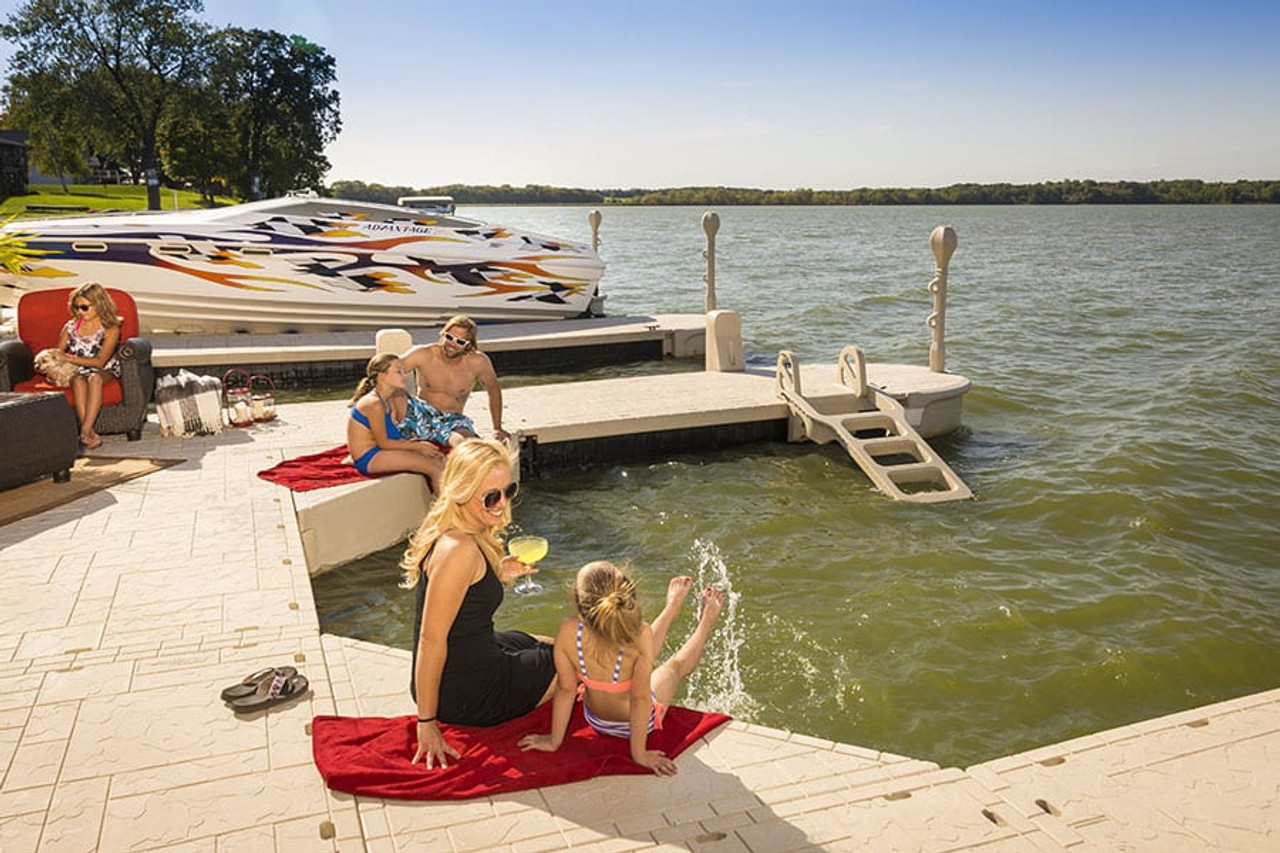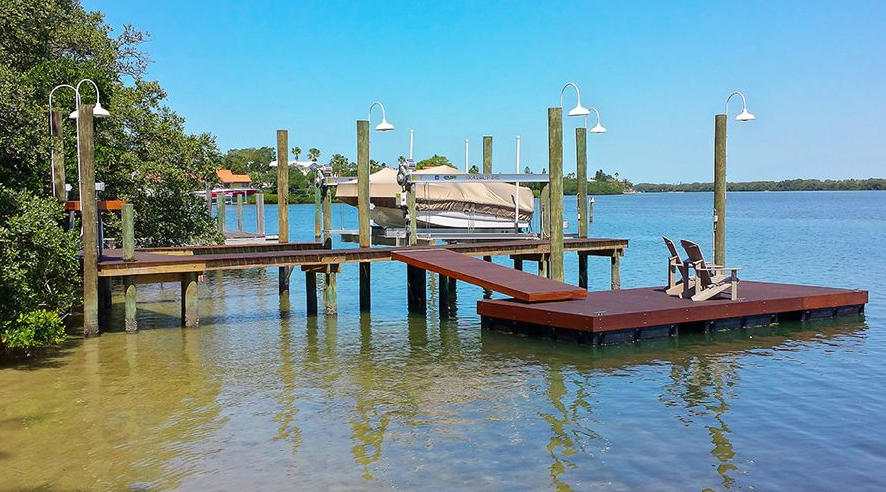Advantages of Working with an Established Floating Dock Company for Peace of Mind
Advantages of Working with an Established Floating Dock Company for Peace of Mind
Blog Article
Create the Perfect Docking Service With Floating Docks
Floating docks present a versatile solution for a range of maritime requirements, adapting effortlessly to varying water levels and diverse vessel kinds. Their modular nature enables for fast installation and moving, yet the option of ideal products and layout features is crucial for making certain both capability and aesthetic allure. As we check out the important aspects that contribute to the performance of floating docks, a number of essential variables relating to stability and maintenance will certainly arise, questioning concerning exactly how to optimize your docking experience. The subsequent discussion will certainly light up these important considerations.

Benefits of Floating Docks
Floating docks offer various advantages that make them a perfect choice for different maritime applications. Unlike repaired docks, floating docks surge and fall with the trend, guaranteeing consistent accessibility for vessels.
Additionally, floating docks are typically simpler and quicker to set up contrasted to conventional fixed frameworks. Their modular design permits straightforward setting up and disassembly, helping with upkeep and relocation when necessary. This versatility is specifically useful for momentary applications or in atmospheres where conditions might change.
Floating docks also have a tendency to be extra eco-friendly, as they lessen disturbance to the seabed and bordering aquatic ecological communities. Their buoyant nature reduces the danger of damages to marine life, advertising a healthier setting. These docks can be tailored to suit numerous vessel sizes, guaranteeing that they meet specific operational requirements.
Inevitably, the combination of versatility, convenience of setup, and ecological factors to consider makes floating docks an extremely effective solution for a wide array of maritime demands.
Choosing the Right Products
Picking the proper materials for floating docks is critical to make certain stability, longevity, and durability. The choice of products directly affects the dock's performance in various environmental conditions, consisting of direct exposure to water, sunshine, and prospective wear from aquatic website traffic.
Typical products used for floating docks consist of light weight aluminum, wood, and high-density polyethylene (HDPE) Light weight aluminum is lightweight, corrosion-resistant, and requires marginal upkeep, making it an exceptional choice for longevity. However, its first cost can be greater contrasted to various other materials.
Wood, while aesthetically appealing and offering a conventional appearance, can be at risk to rot and bug damage if not effectively treated. Consequently, making use of pressure-treated timber or naturally resilient types like cedar or redwood can alleviate these concerns.
HDPE is a preferred option due to its resistance to UV rays and chemicals, along with being ecologically pleasant. floating docks. It is offered and light-weight in different colors, enabling customization
Eventually, the best material choice will certainly depend upon particular needs, including budget plan, desired aesthetics, and ecological factors to consider. Mindful evaluation of these elements will cause a resilient and effective floating dock solution.
Layout Considerations for Stability
When developing floating docks, making certain stability is a basic element that can dramatically impact their performance and safety. Stability in floating dock design is influenced by numerous elements, including buoyancy, weight distribution, and the plan of parts.
Weight distribution is critical; equally dispersing lots throughout the dock protects against turning and boosts stability. This can be achieved via calculated placement of docking tools, such as cleats and fenders, as well as correct spacing of drifts. Furthermore, the dimensions of the dock must be thoughtfully planned. Bigger styles can use enhanced security, particularly read the article in harsh water conditions, while longer docks may call for added supports to prevent sagging.
One more vital consideration is the environmental influence, including wave action and wind. Incorporating attributes such as sidewalls or skirting can help alleviate the impacts of ecological pressures, maintaining stability in More hints damaging problems. Ultimately, a mix of thoughtful layout, material option, and understanding of environmental variables will certainly produce a drifting dock that meets both security and security demands.
Setup Tips and Methods

Following, secure the needed permits and follow regional policies, which might determine installment techniques and ecological factors to consider. If called for, engage a qualified specialist experienced in floating dock installations. Usage top quality materials developed for aquatic environments to improve resilience and longevity.
When positioning the dock, straighten it alongside the shoreline to help with easy gain access to. Make sure that the anchoring system is robust, using cinder block or helical anchors to maintain the dock against wind and wave activity. It's vital to make up seasonal water level variations, consisting of possible ice activity in chillier climates.
Throughout the setup, ascertain the dock's floatation and security prior to completing the anchoring. On a regular basis examine the installation for any indications of wear or damage. By complying with these strategies and ideas, you can accomplish a safe and secure, useful, and aesthetically pleasing floating dock installment that fulfills your requirements.
Upkeep and Care Guidelines
Caring and keeping for floating docks is critical to lengthening their life-span and making certain secure usage. Regular evaluations must be carried out to recognize any type of indicators of wear, damage, or marine growth. Try to find fractures, loose fittings, or discolored locations on the dock's surface area, as these problems can jeopardize structural honesty.
Cleaning up is vital. Make use of a pressure washer to get rid of algae, barnacles, and particles, which can collect with time. For persistent development, take into consideration eco-friendly cleaner that won't harm marine life.
Additionally, examine the mooring lines and anchors regularly to ensure they are complimentary and safe and secure from rust. Replace any torn or harmed lines immediately to keep security.
Throughout severe weather condition, such as tornados or freezing problems, take precautionary steps. Safeguard the dock with extra mooring lines and, if possible, get rid of any kind of removable components to stop damages.
Conclusion
In conclusion, the implementation of floating docks provides a flexible and floating dock services efficient docking option appropriate for various maritime applications. Their versatility to changing water degrees, combined with a modular design, permits very easy personalization and relocation. Picking suitable products boosts both resilience and aesthetic allure, while cautious consideration of security makes sure safety and durability. With appropriate setup and routine upkeep, floating docks can provide efficient and reliable docking experiences for a variety of vessels.
As we discover the essential components that contribute to the effectiveness of floating docks, several crucial variables concerning stability and maintenance will emerge, increasing questions about how to enhance your docking experience. Unlike fixed docks, floating docks increase and fall with the tide, making certain constant accessibility for vessels.When designing floating docks, ensuring stability is a fundamental element that can considerably influence their capability and safety and security. Stability in floating dock layout is influenced by different elements, including buoyancy, weight distribution, and the setup of parts. Ultimately, a mix of thoughtful layout, material option, and understanding of environmental aspects will certainly produce a floating dock that satisfies both security and safety and security requirements.
Report this page